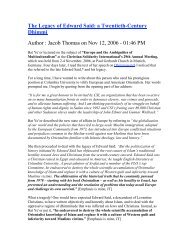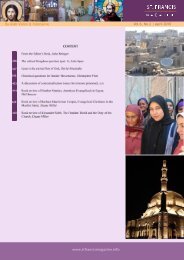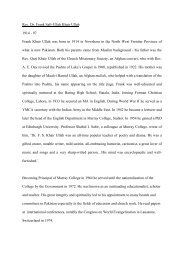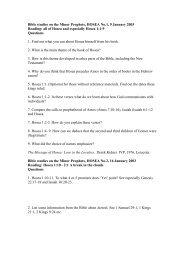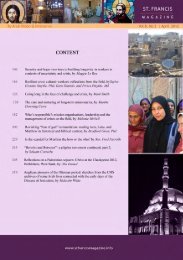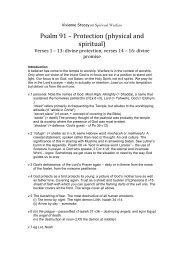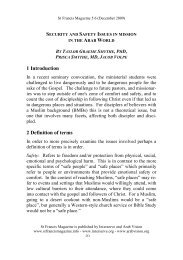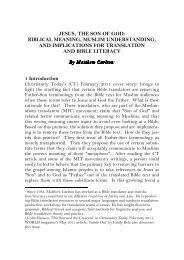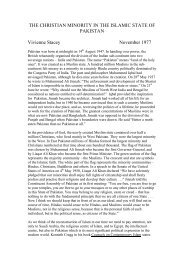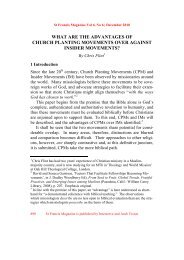Download the pdf - St.Francis Magazine
Download the pdf - St.Francis Magazine
Download the pdf - St.Francis Magazine
Create successful ePaper yourself
Turn your PDF publications into a flip-book with our unique Google optimized e-Paper software.
<strong>St</strong> <strong>Francis</strong> <strong>Magazine</strong> Vol 9, No 4 | August 2013<br />
generally prefers it, yet he has shown sincere appreciation for <strong>the</strong> value of <strong>the</strong> dialectical elements in <strong>the</strong><br />
program and would even attempt to use a little dialect from <strong>the</strong> country of North Africa where <strong>the</strong>y had<br />
lived for a while. 77<br />
Let’s Walk Toge<strong>the</strong>r was a cooperative effort between RSB, GMU and TWR just as Light upon<br />
Light had been during <strong>the</strong> 1980s. RSB and GMU decided to have a different production schedule<br />
now. Each organization would produce all programs during a three-month period, and <strong>the</strong>n rotate.<br />
RSB produced from October-December 1990 and from April-June 1991. 78 Sīkālī was not happy with<br />
<strong>the</strong> three-month rotation:<br />
I have had to make six half-hour programs a week, and I always feel rushed. I don’t have time to really put<br />
something of myself, something deeply personal, into <strong>the</strong> programs. This makes me sad. 79<br />
In October 1991, RSB and GMU decided to change <strong>the</strong> rotational system and tried a new system<br />
of real co-producing. 80 During <strong>the</strong> early 1990s <strong>the</strong>re was an ‘increased ownership of <strong>the</strong> media<br />
ministries by North African believers’. The first materials produced by AWM in North Africa, were<br />
used in 1993. 81 After more than five years of co-producing Let’s Walk Toge<strong>the</strong>r, RSB concluded that<br />
<strong>the</strong> complexity of <strong>the</strong> joint production with GMU exceeded its ability to accomplish what it set out<br />
to do. 82 This decision was taken during a period when RSB’s leaders were avidly trying to set RSB<br />
on a new course with its media ministries.<br />
New Media <strong>St</strong>rategies<br />
RSB had some clearly defined ideas about how radio would develop in <strong>the</strong> years ahead. They<br />
believed that until <strong>the</strong> year 2000 radio would remain <strong>the</strong> predominant mass medium in <strong>the</strong><br />
developing world. Fraser-Smith, Director of RSB from 1988-1993, wrote in Evangelical Missions<br />
Quarterly (EMQ) in 1993 that SW broadcasting would decline and MW broadcasting would be<br />
relegated to ‘an information only role’. RSB assumed that FM and satellite radio stations would<br />
expand to become <strong>the</strong> main entertainment sources. 83<br />
Those comments about <strong>the</strong> future role of SW, MW, FM and satellite radio reflected <strong>the</strong> results of<br />
a survey and interviews done in 1992 among 90 Arab Christian leaders and 60 expatriate<br />
missionaries in <strong>the</strong> Arab world. Comments from <strong>the</strong> central Middle East and North Africa indicated<br />
a very low interest and support for <strong>the</strong> continuation of short wave radio broadcasting. Both Arab<br />
nationals and expatriates felt that we need to monitor closely <strong>the</strong> changes in radio broadcast<br />
technology and be ready to exploit new opportunities on medium wave, FM and through radio-bysatellite,<br />
when such services begin. 84<br />
The report recommended that it should be ‘a priority that Christian radio broadcasters make<br />
increasing use of medium wave, local FM and future radio-by-satellite opportunities to reach <strong>the</strong><br />
Middle East/North Africa’. 85 The report noted that Arab nationals, in general, appreciated Christian<br />
radio as being an effective medium to reach non-Christians, especially in places with no official<br />
church. 86<br />
In 1993 RSB decided to add video production to its media work in Marseille. It seemed <strong>the</strong> role<br />
of radio in AWM was decreasing. The first step in RSB’s involvement in video was in 1993 when<br />
77<br />
<strong>St</strong>eve Vishanoff in an email to author (29 September 2004).<br />
78 ‘Walking Toge<strong>the</strong>r’, in Contact (February 1991), p. 1. ‘Triple Partnership’, in Contact (February 1991), p. 1. ‘Arab World<br />
Media - in Action’, in Contact (April 1991), p. 2. ‘For information & Intercession’, in Contact (September 1991), p. 2.<br />
79 ‘Team Effort’, in Contact (February 1991), pp. 1-2.<br />
80 Keith Fraser-Smith, ‘Media: Reaching <strong>the</strong> Arab World’, in Frontline (December 1991-January 1992), p. 2.<br />
81 ‘An Eye to <strong>the</strong> Future’, in Contact (February 1993), p. 1.<br />
82 More about <strong>the</strong> reason for <strong>the</strong> breakup of <strong>the</strong> cooperation is in chapter 17 of <strong>the</strong> <strong>the</strong>sis, on GMU.<br />
83 Anonymous, ‘The Mass Media and Church Planting in Restricted Access Countries’, in Evangelical Missions Quarterly<br />
(July 1993), pp. 279-280. This anonymous writer was Keith Fraser-Smith.<br />
84 Abu Wasiim (ed), Christian Mission in <strong>the</strong> Arab World: A Comprehensive Analysis of <strong>the</strong> Arab World– and Priorities for<br />
Christian Witness Today (2 nd edition, Nicosia, 1993), p. 45.<br />
85 Ibid, p. 89.<br />
86 Ibid., p. 45.<br />
<strong>St</strong> <strong>Francis</strong> <strong>Magazine</strong> is published by Arab Vision and Interserve 11




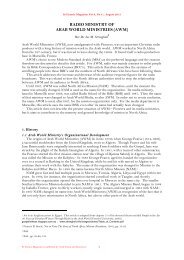
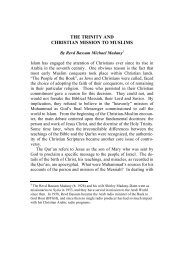
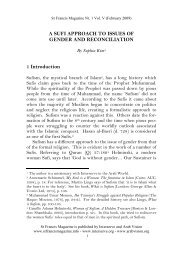
![Reflections on Surah Fatiha and the Lord's Prayer[1] - St.Francis ...](https://img.yumpu.com/49377951/1/184x260/reflections-on-surah-fatiha-and-the-lords-prayer1-stfrancis-.jpg?quality=85)
